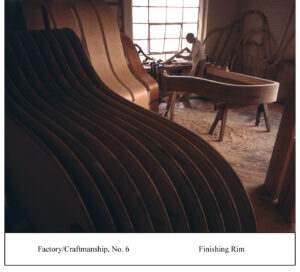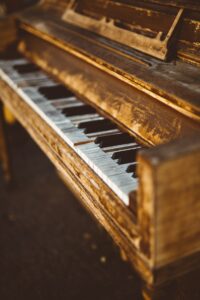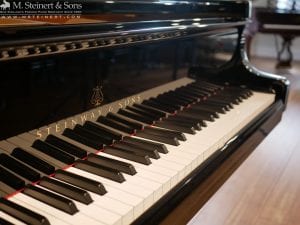We are contacted every day by people asking about the value of their piano. Usually, this is a piano that they have either recently acquired (or are considering acquiring) or are planning to relinquish. Pianos are large and often difficult to move, so this question often comes from people with an imminent or recent real estate transaction.
Top reasons people ask this question:
“I’m downsizing and can’t take my piano with me”
“I’ve just moved and the previous owners left this piano in the living room”
“I’ve just inherited my family’s old piano.”
“I’ve just bought a new house and am considering buying a used piano.”
-
- If this last one is you, please read our article: What is the Best Piano for a Beginner
- If this last one is you, please read our article: What is the Best Piano for a Beginner
DECIPHERING THE VALUE OF YOUR PIANO
In this article we’ll discuss what factors contribute to a piano’s value (hint… it isn’t antiquity) to help you determine the best next steps for you and your piano. Is your piano something that could net you some extra cash or is it something you’ll need to pay to have disposed of?
M. Steinert & Sons has been in the piano business for 160 years and has experienced almost every age/condition/piano imaginable. The first thing we like to let people know is there isn’t a credible “Blue Book” for piano values like there is for cars, coins etc.
The most important thing to understand is that a piano gains the majority of its value from its musical quality. This has been true throughout the piano’s 300+ year history with very few exceptions. Age does not make a piano worth more; it makes it worth less. We expand on this in our New Vs Used Steinway article.
WHAT FACTORS CONTRIBUTE TO A PIANO'S VALUE?
Three main factors determine the actual value of a piano (in order of importance):
1. Musical Quality
2. Condition
3. Furniture/Style
WHAT FACTORS AFFECT MUSICAL QUALITY?
1. Manufacturer’s Design/Construction:
Did you know that there were over 1000 piano manufacturers in America during the turn of the 20th century? Today there is only one of significance; Steinway & Sons. Most American piano factories were located on the eastern seaboard between Washington DC and Boston. There were many tens of thousands of pianos built between 1890 and 1940 and a number of those pianos still survive today in some form.
Then, as now, there were builders of varying quality; Steinway & Sons in New York and Chickering & Sons from Boston were some of the high-quality builders. There were many others of differing quality including our own firm M. Steinert & Sons which built pianos in two factories in Leominster MA under the names Jewett, Hume, Woodbury, and Steinert.

Original Design and Construction determines a pianos musical potential and longevity.
Manufacturers and brands that retain the most value and are most re-sellable on the open market:
- Steinway & Sons pianos less than 40 years old (30 years old is the cutoff to be considered for the Steinway Certified Pre-Owned Program)
- Yamaha and Kawai pianos less than 15 years old
- Steinway Designed Boston and Essex
- Samick pianos (including Knabe, Kohler & Campbell, Pramberger, Seiler, etc) less than 15 years old
- Pearl River pianos less than 10 years old
- Higher-end European Manufacturers less than 20 years old, such as Bosendorfer, Fazioli, and Bechstein to name a few.
European Made Pianos and Grey Market Yamaha
While on the subjectof European-Made pianos, it is important to understand the effects of ambient climate on a piano. Seasonal and daily changes in temperature and humidity will have dramatic effects on a piano. Many of the more expensive European brands utilize native European lumber. They are designed for the European climate, which tends to be milder by comparison to much of North America, particularly when compared to the Northeast United States. This is why antique European furniture often experiences rapid deterioration when moved to the more hostile New England environment.
Also of note, many Asian-built pianos are less resistant to seasonal climate variations in North America. The construction process in low-cost pianos values cost and speed of construction over high-quality materials/woods and respecting their curing time. As a result, many Asian-built pianos deteriorate rapidly in the North American climate. In fact, Yamaha notes on their website that it builds pianos “not suitable for the US Market.” https://www.yamaha.com/ussub/pianos/SerialNumberlookup.aspx
Experience has suggested many of the used Yamaha pianos being brought to North America today are pianos that were manufactured for the Japanese market…also known as ‘grey market’ pianos. Based on Yamaha’s experience with pianos not seasoned for the US market, we strongly discourage the purchase.
2. Age/Condition
As you can glean from the above, actual condition is more important than the manufacturer. Over time, as a piano is subjected to the environment, the stress-bearing materials (wood, felt, wire) degrade.

Unfortunately, the majority of pianos over 40 years old have zero or negative value. Negative value would be due to the cost of removing and disposing of non-functional pianos.
One exception to this rule; Steinway & Sons grand pianos retain some residual value in advanced age and poor condition. This is a testament to the Steinway design and the longevity of Steinway & Sons as a company. The design allows the piano to be rebuilt, have components replaced, and be restored. The longevity of the company means there is access to parts and expertise to allow high-quality restoration. Rebuilding a Steinway & Sons piano is not an inexpensive or easy proposition. As such, the residual value is fairly limited for these pianos. For more information on rebuilding Steinway pianos, please see our articles:
https://msteinert.com/blog/pros-and-cons-of-new-vs-rebuilt-steinway
3. Furniture/Style effect on value
Pianos of the past are often appreciated for their esthetic value as furniture pieces. Some furniture styles are less popular today than in the past and don’t fit with current preferences in décor. For some, these styles are preferred. Taste is always in flux.
Today, there is a general trend away from wood grain exterior veneer to a preference for ‘classic’ black. This preference has shifted over the years – and has been tilting towards black polish finishes. Todeay, a flawless black polish finish increases the value of the piano.
Sentimental Value?
We understand that many instruments are imbued with a history associated with long-term family usage and joyous moments spent around an instrument. This becomes a sensitive and difficult part of the valuation process for many. It also leads many to search for rebuilding or restoration services that will often cost more than the instrument could ever be worth. See our article on Pros and Cons of New vs Rebuilt Steinway
Nostalgia and emotion have historically prevented non-functional pianos from being disposed of. As a result, living rooms, dens, basements, attics, and parlors in America are still populated by old pianos in poor condition with no real monetary or musical value.
SO – WHAT'S MY PIANO WORTH?
Here’s a simple chart that gives you a range of possibilities based on our experience for piano values:
| Piano Type | Age | Approximate Value Range |
|---|---|---|
Steinway & Sons |
||
Steinway & Sons |
40+ years |
$1,000- $15,000 “shell value” |
Steinway & Sons |
5-10 years |
Around 80% of new $60,000 to $90,000 |
Steinway & Sons |
10-20 years |
60-70 % of new $45,000 to $70,000 |
Steinway & Sons |
20-30 years |
50% of new $40,000 – $60,000 |
Yamaha/Kawai/Samick |
|
|
Yamaha/Kawai/Samick |
30+ years |
Zero to -$400 |
Yamaha/Kawai/Samick |
20-30 years |
$0 – $5,000 |
Yamaha/Kawai/Samick |
10-20 years |
$2,000-$20,000 |
Known European Make |
|
|
Known European Make |
40+ years |
$0 to $20,000 |
Known European Make |
20-40 years |
$1,000 to $20,000 |
Known European Make |
5-20 years |
$10,000 to $50,000 |
American Piano No Longer Produced |
40+ years |
$0 to $5,000 (consider our popular article: What do I do with my old piano?) |
WILL YOU BUY MY PIANO?
If after reading this article you determine that your piano still has significant musical value – feel free to complete our piano evaluation form and we’ll let you know our interest in purchasing within 7 days.

